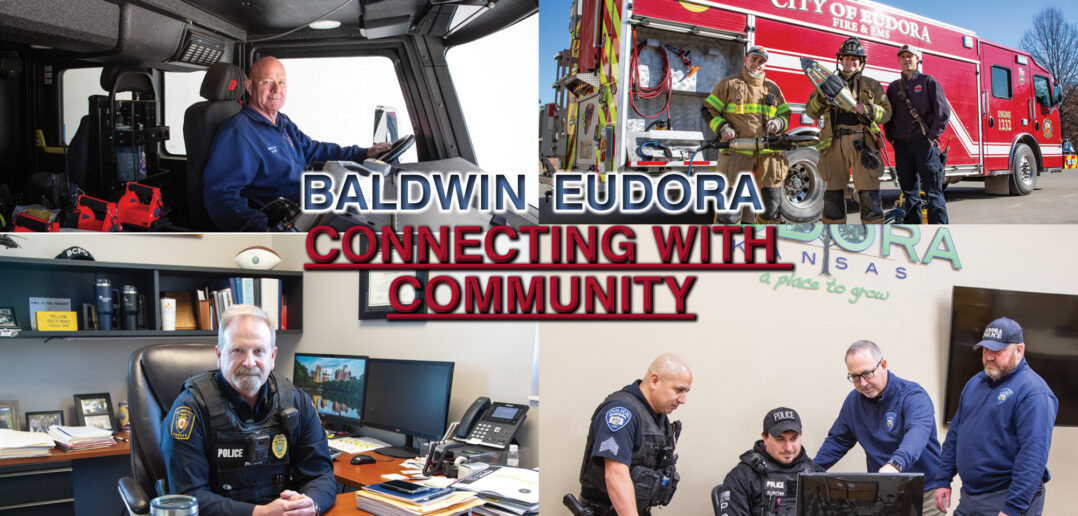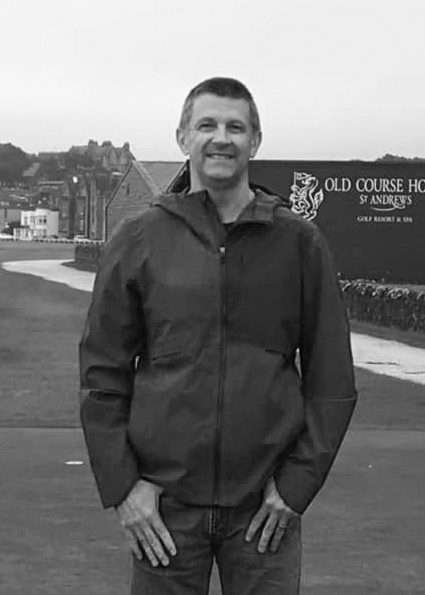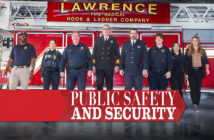| story by | |
| photos by | Steven Hertzog |
| OPEN A PDF OF THE ARTICLE |
The slower pace of small-town life and familiarity of townspeople allows public safety officers to get to know the people who live there while also receiving fewer service calls.
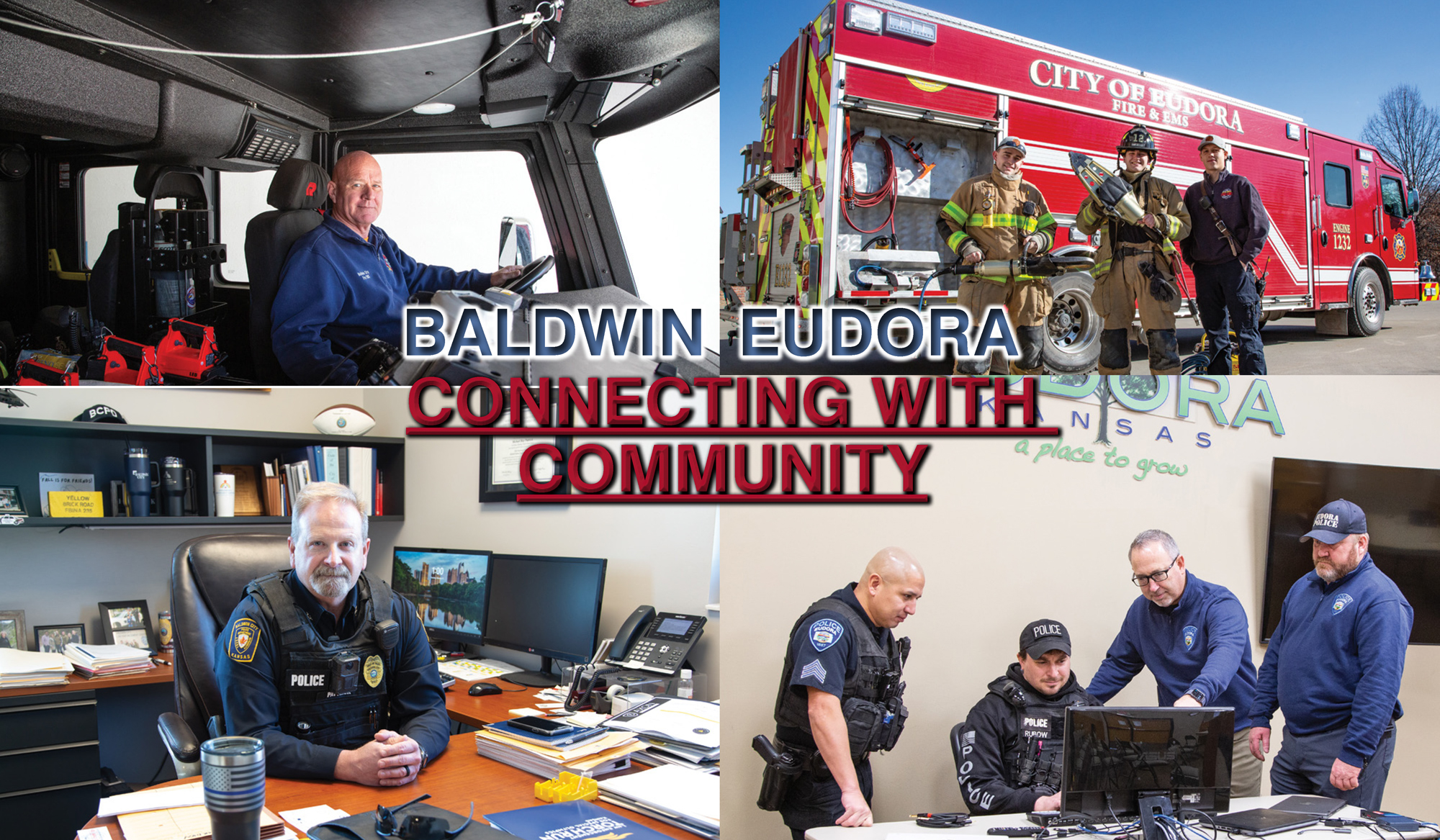
Baldwin and Eudora
There’s something special about small towns. The friendly relationships among neighbors and slower pace make them unique compared to larger cities.
Somewhat naturally, these distinctive attributes bleed into the experiences of those working in public safety in rural communities. Police officers getting called to the scene of an incident are more than likely going to know those for whom they are responding. They very possibly could be closely related. Fire first responders racing to a structure blaze or a medical emergency have a decent chance of having an outside relationship with a respondent, be it friend or family.
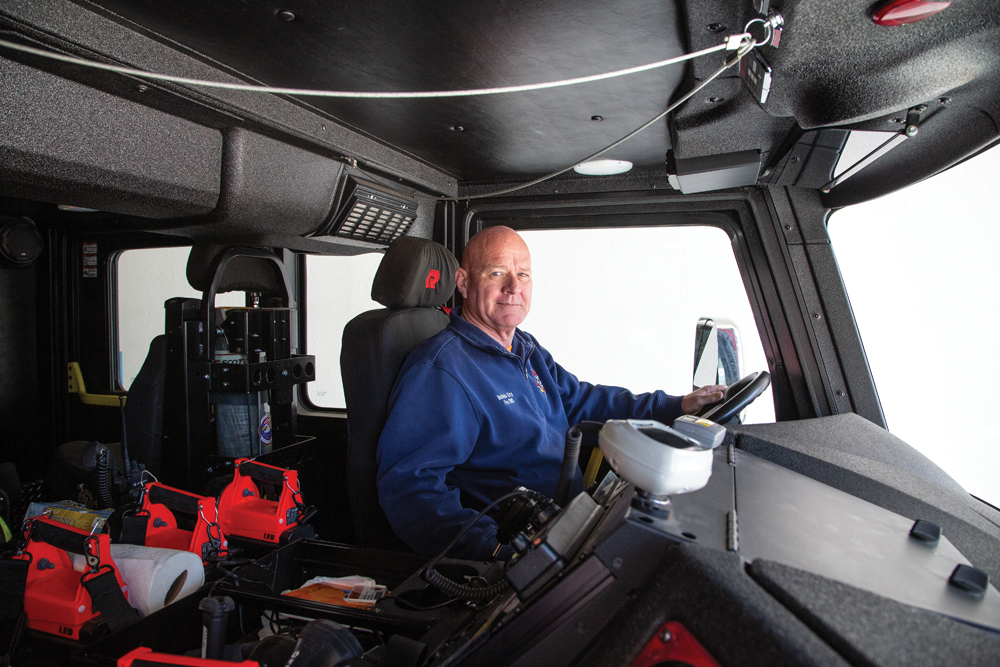
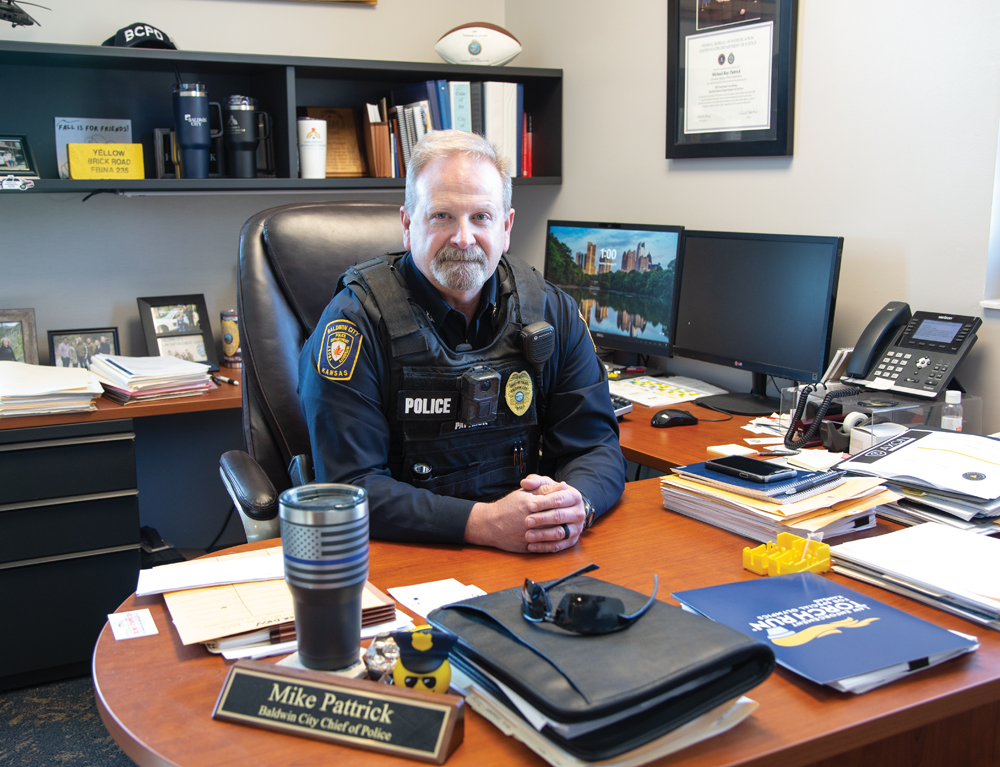
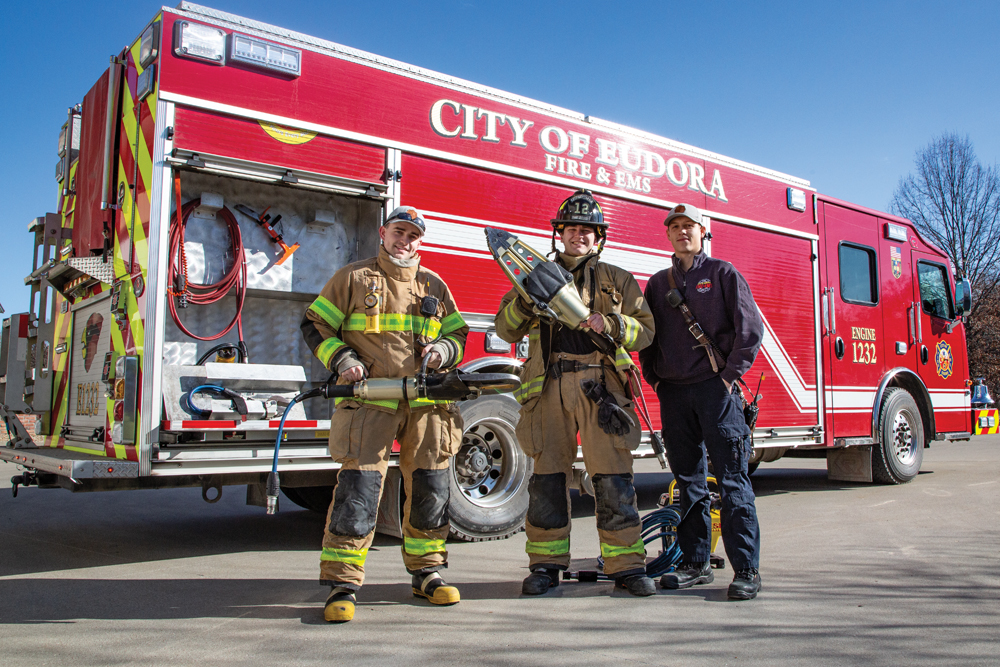
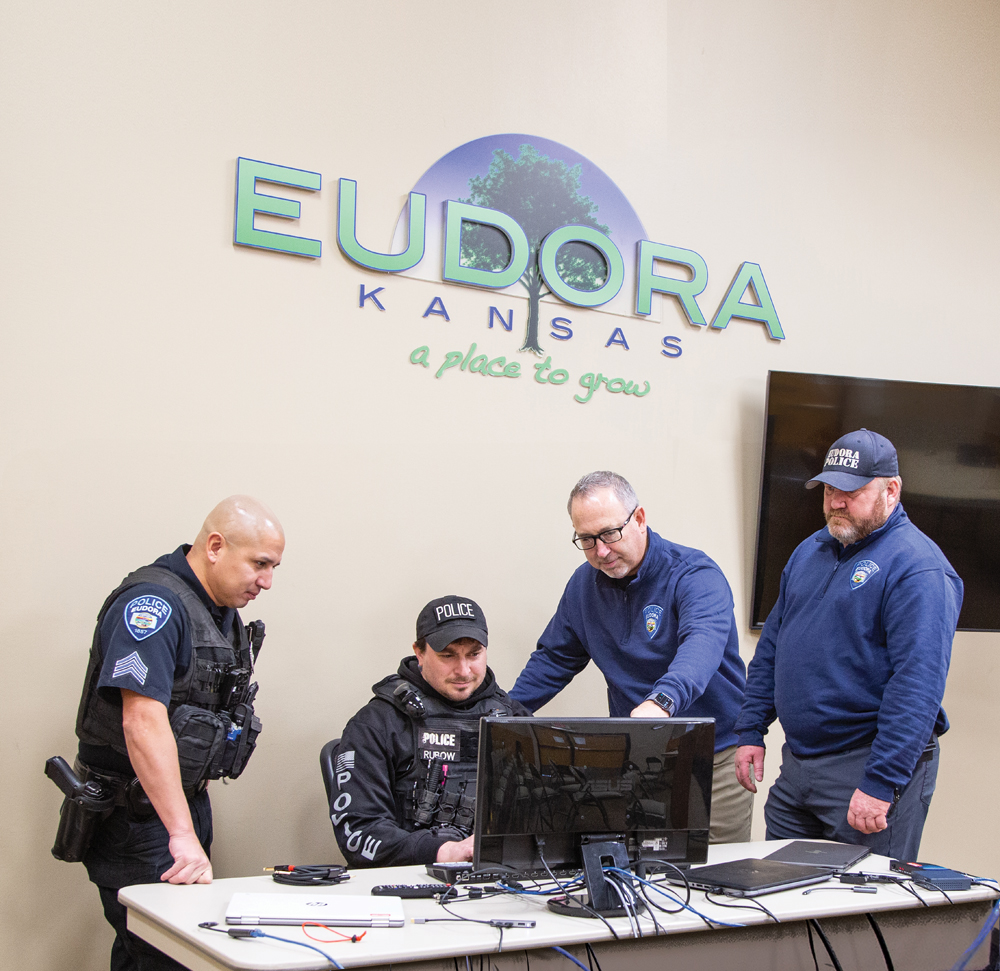 top to bottom: Baldwin Fire Chief Terry Baker; Baldwin Police Chief Mike Pattrick; Eudora Fire Department Volunteers Jacob Hankins, Chris Wolfe and Drake Patty-FF/EMT; Eudora Police Chief Wes Lovett looking over daily plans with officers
top to bottom: Baldwin Fire Chief Terry Baker; Baldwin Police Chief Mike Pattrick; Eudora Fire Department Volunteers Jacob Hankins, Chris Wolfe and Drake Patty-FF/EMT; Eudora Police Chief Wes Lovett looking over daily plans with officers
Ask a police officer, firefighter or paramedic how maintaining close relationships with the city fits with their job descriptions, and they’ll tell you it’s paramount to effectively keeping their communities safe and something they strive to improve upon every day.
“I love the size of this community,” says Eudora Chief of Police Wes Lovett, who came to Eudora, a small burg of about 6,500 a few miles east of Lawrence, seven years ago after 24 years working for the police department in Prairie Village, Kansas. “I love the pace. It’s different than what I’m used to in a bigger city.”
Mike Pattrick, chief of police in 4,700-population Baldwin City, says, “Everything we do is pretty much the same as in a big city, it’s just scaled down. We have fewer calls for service, but we have fewer people to respond.
“Baldwin City is a very nice community. We have very few calls where there’s violence involved. It’s a very supportive community,” Pattrick says. “To work in Baldwin City is a very nice thing.”
Both Lovett and Pattrick stress that fostering small-town relationships is key to being effective public safety officers and first responders in their respective communities. Police officers are much more than ticket writers or keg party breaker-uppers, just as much as fire department folks aren’t simply putting out fires or answering emergency medical calls. They’re friends and pillars of their towns and constantly engaging with the townspeople they serve.
For instance, the Eudora Police Department hosts events like “coffee with a cop,” “ice cream cones with a cop,” “pizza on patrol” and “lunch with law enforcement.”
“Sometimes, a grade-school kid might have a negative interaction with an officer,” Lovett says. “Sitting down and having lunch with that kid not only provides a positive interaction, but it only enhances our relationship with them.”
Working for Community’s Benefit
LOCAL MATTERS
Our Local Advertisers – Making a Positive Impact
Nothing says caring for a community more than volunteering. And the Baldwin City Fire Department knows this all too well.
The department is made up of 12 firefighters—including two female members and one minority member—who all volunteer. They are only paid when they make calls and all hold down full-time jobs elsewhere. The department’s chief, Terry Baker, also runs a cattle operation near town and typically answers calls out of his farm truck 24 hours a day, seven days a week.
“If you think about the hours, it’s full time,” Baker says. “None of us are making a living doing this. But all of us who volunteer just want to give back to the community.
“We work really hard at being community-based,” he adds.
Baker says his department answers 3.7 calls per day on average and made more than 800 calls in 2023. It answers all medical calls in Palmyra District 2 but also works with the Lawrence Fire Department if it needs assistance or can be of assistance. It all adds up to a very busy schedule that also includes training, during which volunteers are not paid.
“It takes a special person to be a volunteer firefighter,” Baker says. “I’ve walked out of my house Christmas morning to take a call. People don’t understand what all we have to keep up on. My wife is starting to finally understand it after 15 years.”
Firefighting has gone through a lot of changes over the years because of technological advancements that have made “everything lighter weight and better,” Baker explains. Thermal-imaging cameras have improved, personal gear is lighter and more mobile, fire trucks are safer … . There’s even an app on firefighters’ smartphones that gives details on the jobs to which they’re called.
The biggest challenge he says he’s faced is recruitment of new volunteer firefighters.
“It’s the toughest thing you can imagine,” Baker continues. “No one wants to give up their free time anymore. You have to be willing to give up the time, and that’s the problem.
“But the guys I work with now, I trust with my life,” he says.
Baker sees the recruiting challenges easing in the coming years, however. Another technological advancement involves the rise of social media, and he says he’s using it extensively in recruiting new volunteers. Also, he’s hoping within the next five years or so he and his firefighters won’t have to be volunteers.
“What’s important to me over the next five years is getting the money to hire full-time firefighters,” Baker adds.
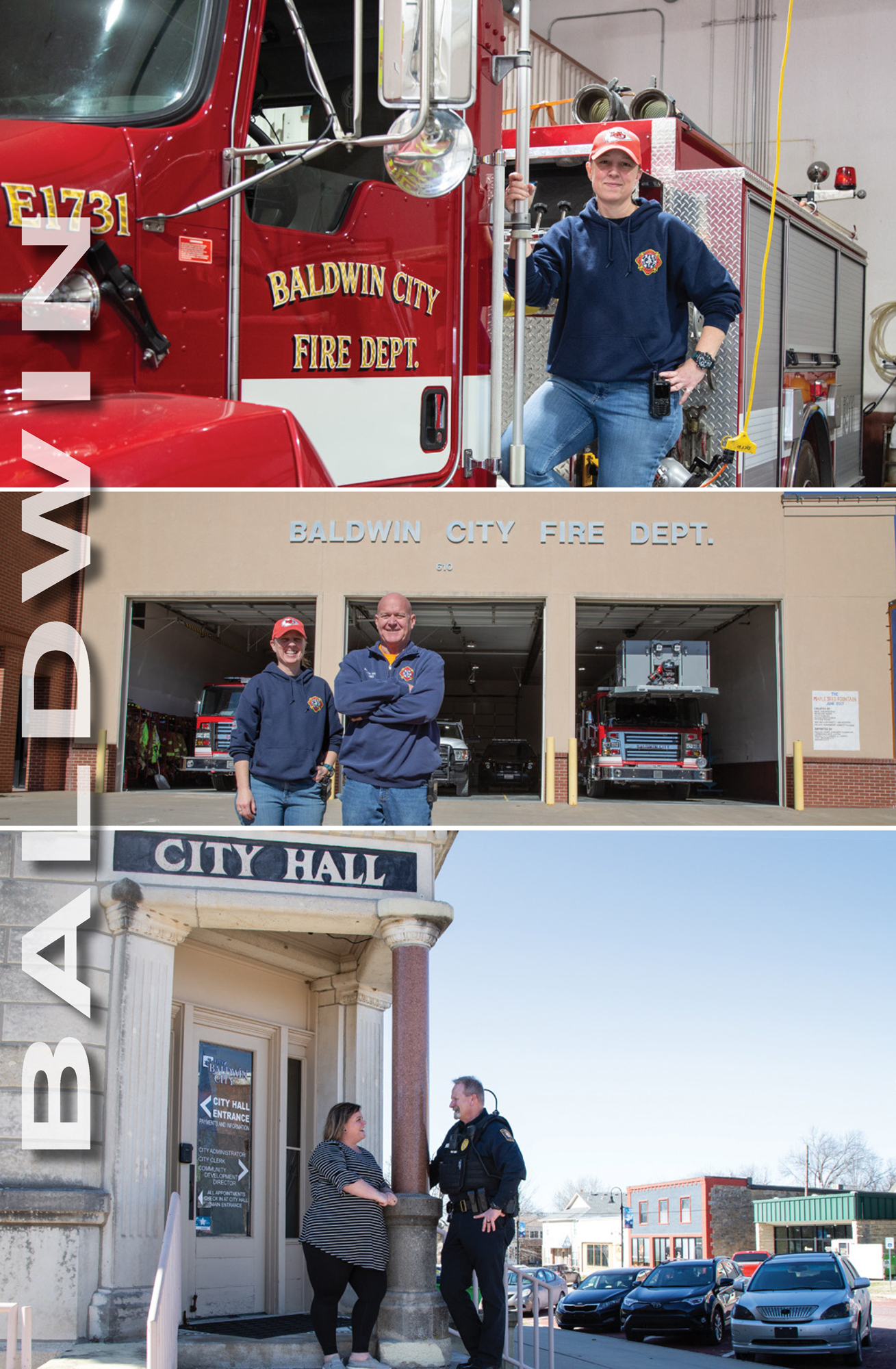
Baldwin Fire Dept Volunteer Becky Catron; Baldwin Fire Chief Terry Baker and Becky Catron pose in front of the Baldwin City Fire Station; Baldwin Police Chief Mike Pattrick and Baldwin Chamber of Commerce President Jenni Fish
A Whole Different World
Eudora has what’s called a combination fire department. It has three paid employees: Chief Mindy Andrasevits, Assistant Chief Chris Hull and a part-time firefighter position that is filled 7 a.m. to 7 p.m. every day by different firefighters. All others are volunteers and paid per call. The department tries to maintain a volunteer roster of about 40 firefighters, but that can fluctuate. Volunteers are required to be on the job 108 hours per quarter.
Andrasevits arrived in Eudora two years ago from St. Joseph, Missouri, where she worked with a full-time paid department.
“It’s similar but different,” she says. “We’re not any less busy here. A regular day doesn’t change.”
Andrasevits says surprisingly, calls were down six percent in 2023, 774 compared to 825 the year before. She anticipates that number growing to more than 1,000 in coming years as Eudora’s population grows.
Also somewhat surprising, she says she hasn’t shared the same challenges as Eudora’s neighbors to the south in Baldwin City. Many of her volunteers work full time as firefighters for neighboring districts.
“During my time here, I’ve been most amazed at recruitment,” Andrasevits explains. “The Eudora department has a long-standing reputation for being professional, having good training, proximity to larger departments.
“When we recruit, we’re often turning people away,” she adds.
While Andrasevits says her department “is not in a position right now to recruit specifically for diversity,” she currently has four female firefighters, one of whom is a lieutenant and two of whom are paramedics.
“In our department, word of mouth is so important for recruiting,” she says.
Like Chief Lovett in the Eudora Police Department, Andrasevits says she’s constantly working hard to see to it her volunteers are out in the community making connections and forging working relationships.
“A huge part of what we do is community outreach,” she says. “We have programs with the schools. We like to be seen and heard, and be part of as many things as we can.
“Eudora is going to change dramatically in the next few years, and the fire department is going to have to, as well,” she continues. “We’re proud that we’re a part of a community that’s growing and making sure public safety is part of that.”
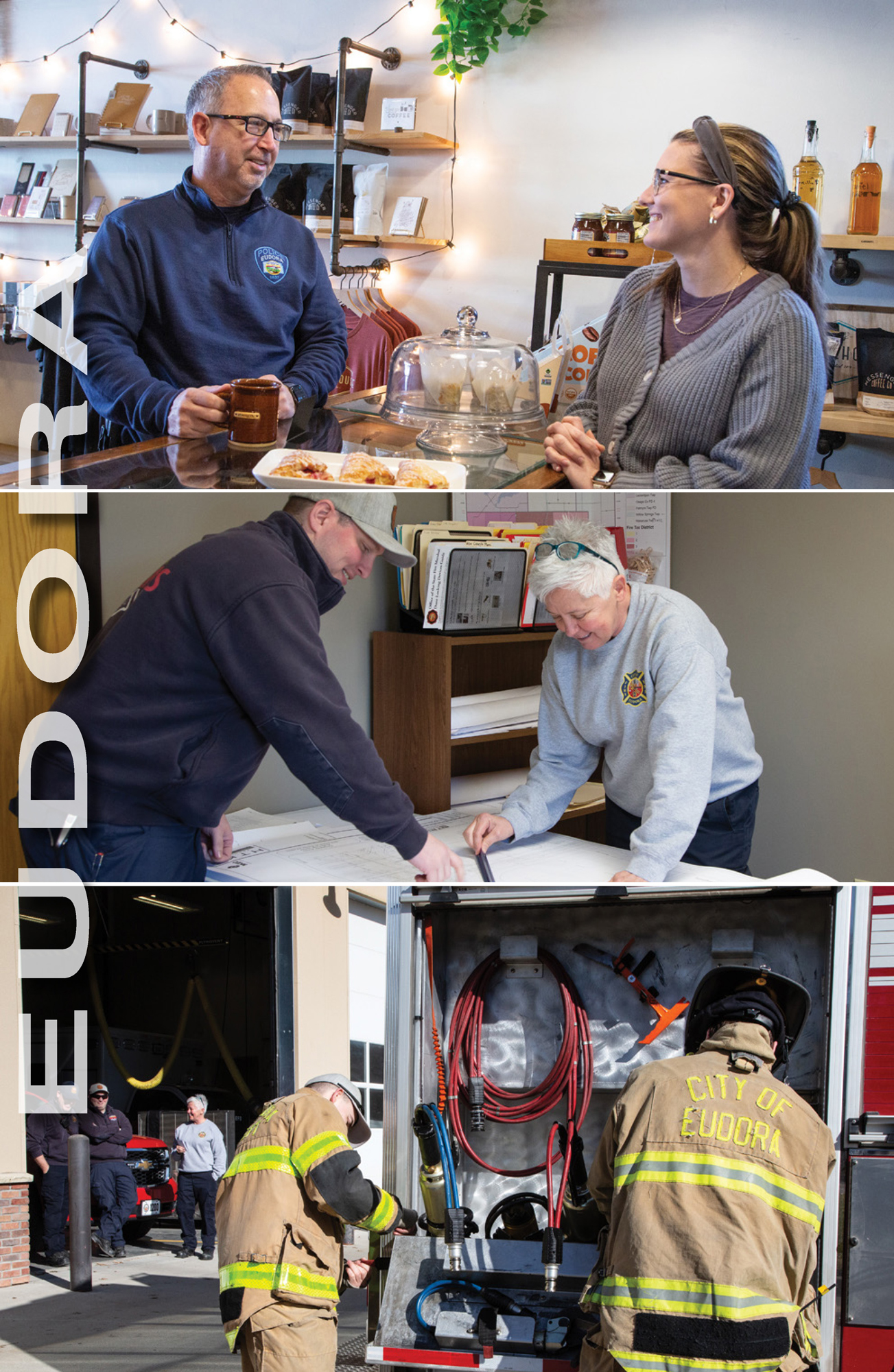
Eudora Police Chief Wes Lovett visiting business owner Kathy Weld of Zeb’s Coffeehouse; Eudora Fire Chief Mindy Andrasevits and assistant Chief Chris Hull; Eudora Fire Dept volunteers prepare their fire truck
The Changing Nature of Policing
The Eudora Police Department has 15 sworn officers (including a female school resource officer and two Hispanic sergeants), one part-time administrative assistant and a full-time court clerk, as well as 10 official police vehicles. Lovett says technology has completely altered the nature of those vehicles.
“Today, we have in-car (cameras), body cams,” he says. “Every car has a mobile data terminal in the car. You can basically do everything you need to in police work and never leave the car. It’s come a long way.”
That, of course, works counter to what Lovett wants from his patrol officers. Just like Andrasevits with the fire department or Pattrick and Baker in Baldwin City, Lovett wants his officers out of their cars and interacting with the community.
“We always have a presence at the (Chamber of Commerce’s) First Thursdays,” he says. “We usually have four patrol officers at every Friday-night football game.”
His department also sponsors at least five families at Christmastime, bringing gifts to homes and helping decorate trees. One of Lovett’s sergeants work with an organization called Hands to Heart to hand out toys to about 200 kids.
“They’re all ways to connect with citizens,” he explains. “We’re very fortunate to have the relationship we have with the community.”
Though Lovett admits recruiting new officers can be challenging, he maintains he’s avoided much of that challenge because of the closeness between police and citizenry.
“We’re fortunate we’re fully staffed,” he says. “We’ve hired quite a few people that grew up here, people who are dedicated to keeping our community safe.”
The biggest challenge in the coming years, Lovett says, will be keeping up with the growth brought about by the new Panasonic facility being built a few miles east, in DeSoto. It’s anticipated the plant will hire at least 4,000 new employees, and it’s reasonable to expect many of those workers will move into Eudora.
“That growth will bring in a lot of businesses to the area,” he continues. “Our biggest challenge will be adding people.”
The Best They Can Be
Including Chief Pattrick, the Baldwin City Police Department has a force of 11 sworn officers, which includes two sergeants and eight officers. There also are two civilian staffers and three part-time positions that help out with special events. The department not only services the city limits, including Spring Lake, but also is law enforcement for Baker University. It has eight patrol vehicles.
The quiet, small-town nature of Baldwin City allows its police ample opportunity to get more involved in the community on a more personal level.
“Since our call volume is not as heavy, we have more opportunity to interact with the community on noncall situations,” Pattrick says. “Visibility is easier for us with the city not being as large.”
Still, he believes the public doesn’t always understand the amount of work police officers do behind the scenes to properly prepare for on-call matters and scenarios.
“They don’t understand the professionalism and time these officers put in to be the best,” Pattrick explains. “They all want to be the best police officers they can be.”
One challenge he sees is that improved technology has made everything instant. In the digital age, no longer is there lag time in communication. Being unreachable isn’t a thing anymore. People today are accustomed to quick turnarounds and responses at the drop of a second. Also, in the age of social media, privacy appears to be a thing of the past.
“It’s just a matter of getting to everyone and everything in as timely a manner as possible,” Pattrick says.
Like most other small-town forces, recruitment is a challenge in Baldwin City, he adds. What isn’t a challenge, however, is retention.
“Right now, it’s hard to retain young, enthusiastic people with the amount of pay we can offer,” Pattrick says. “There are so many agencies out there looking for good people.
“But, once we find the right people, they stay with it,” he says.

